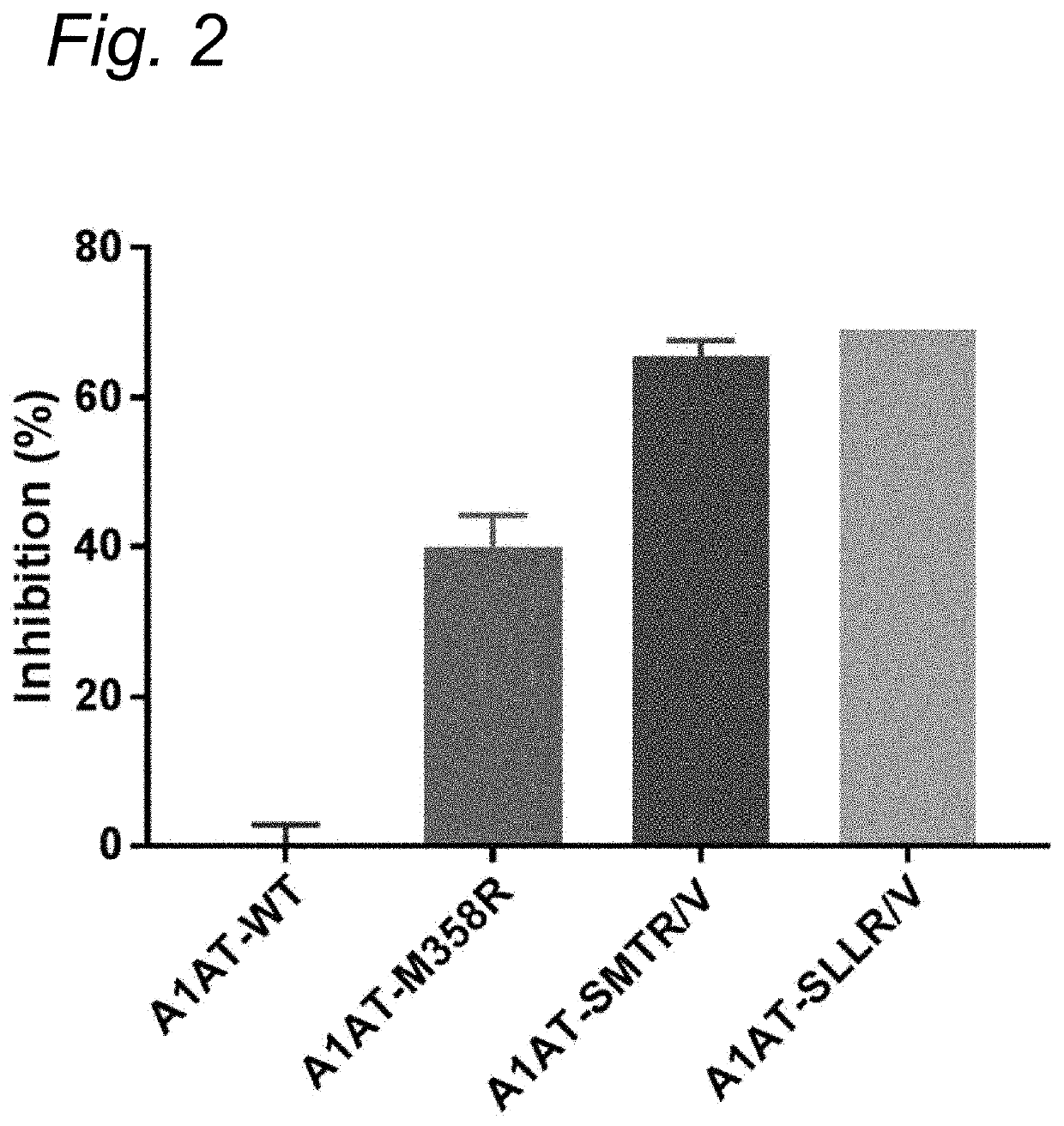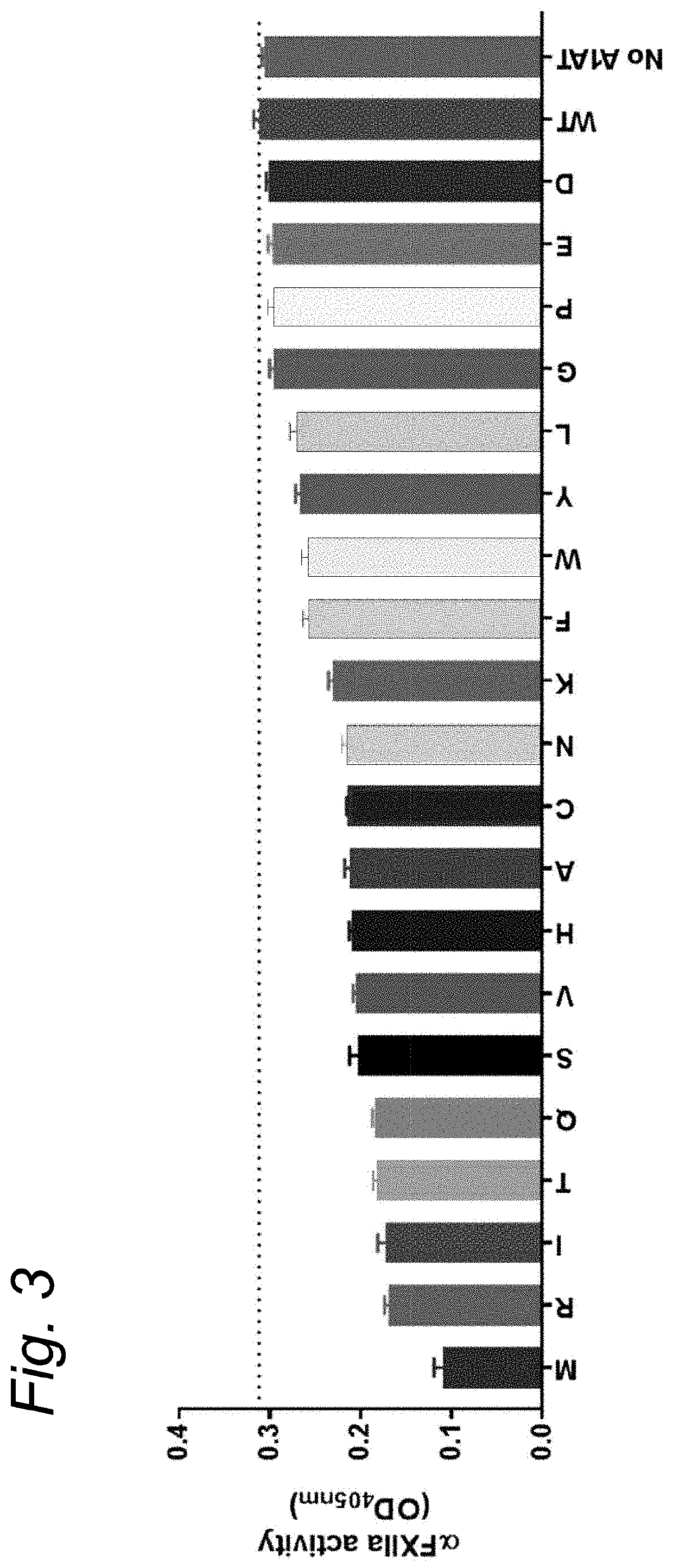Modified serpins for the treatment of bradykinin-mediated disease
a technology of serine protease inhibitors and serpins, which is applied in the field of medicine and pharmacy, can solve the problems of uncontrollable bradykinin production, unsatisfactory therapy, and pain and dangerous attacks of tissue swelling
- Summary
- Abstract
- Description
- Claims
- Application Information
AI Technical Summary
Benefits of technology
Problems solved by technology
Method used
Image
Examples
example 1
[0131]Modified Serpin Construction
[0132]The SERPINA1 cDNA sequence was obtained from the NCBI database (NM_001127707.1). The sequence coding for the signal peptide was discarded and replaced by a sequence coding for a Tobacco Etch Virus cleavage site. At the 5′ side an EcoRI digestion site was added and at the 3′ side and NotI digestion was added after the STOP codon of SERPINA1. Hereafter the 354AIPM358 sequence (amino acid numbering without the signal peptide) was replaced with SMTR sequence (Codon sequence was grafted from wild type F12 NCBI: NM_000505.3). The construct was obtained from IDT (Integrated DNA Technologies, Leuven, Belgium)) as a custom gene construct. The custom gene construct was propagated in top E. coli TOP10 and selected by ampicillin resistance. Obtained plasmid DNA was digested by EcoR1 and NotI. The resulting insert (1223 bp) was separated on and isolated from agarose gel and ligated into a modified pcDNA6 expression vector (pSM2) (De Maat et al, 2016 Clin I...
example 2
[0134]α1-Antitrypsin Expression
[0135]The SERPINA1-pSM2 constructs were transfected into HEK293 FreeStyle™ cells using 239Fectin as instructed by the manufacturer (ThermoFisher). After 4 days of protein production, the cells were spun down at 2000×g for 5 minutes. Hereafter the supernatant was collected and stored at −20° C. until further use.
example 3
[0136]Enzyme Inhibition by Δ1-Antitrypsin Variants
[0137]10 μl of supernatant containing the α1-Antitrypsin variants was incubated with 10 μl of enzyme and 20 μl of buffer (0.2% w / v bovine serum albumin in Hepes buffered saline: 10 mM HEPES, 150 mM NaCl, pH=7.4). After a 5 minute incubation the substrate was added and substrate conversion was monitored according to substrate specifications. Inhibition percentage was determined within the linear part of the substrate conversion, where substrate conversion without the presence of any αl-AT variant was set as 0% inhibition.
[0138]Enzymes[0139]Human αFXIIa (final concentration: 2 μg / mL)[0140]Human βFXIIa (final concentration: 0.7 μg / mL)[0141]Plasma kallikrein (final concentration: 2 μg / mL)[0142]Thrombin (final concentration: 2 U / mL)[0143]Plasmin (final concentration: 2 μg / mL)[0144]Activated protein C (final concentration: 2 μg / mL)
[0145]Substrates
FinalEnzymeSubstrateConcentrationMethodWavelengthFXIIaL21200.5 mMAbsorption405 nmPKL21200.5 mM...
PUM
| Property | Measurement | Unit |
|---|---|---|
| half-life time | aaaaa | aaaaa |
| ionic strength | aaaaa | aaaaa |
| temperature | aaaaa | aaaaa |
Abstract
Description
Claims
Application Information
 Login to View More
Login to View More - R&D
- Intellectual Property
- Life Sciences
- Materials
- Tech Scout
- Unparalleled Data Quality
- Higher Quality Content
- 60% Fewer Hallucinations
Browse by: Latest US Patents, China's latest patents, Technical Efficacy Thesaurus, Application Domain, Technology Topic, Popular Technical Reports.
© 2025 PatSnap. All rights reserved.Legal|Privacy policy|Modern Slavery Act Transparency Statement|Sitemap|About US| Contact US: help@patsnap.com



